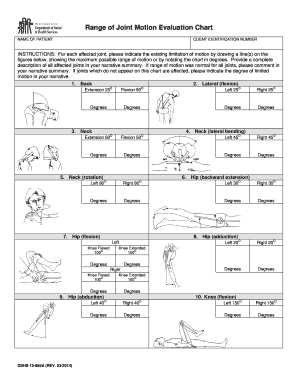Loading

Get Normal Range Of Motion Chart 2020-2025
How it works
-
Open form follow the instructions
-
Easily sign the form with your finger
-
Send filled & signed form or save
How to fill out the Normal Range Of Motion Chart online
Filling out the Normal Range Of Motion Chart is essential for accurately documenting a patient's joint mobility. This guide provides step-by-step instructions to help you navigate the process online effectively.
Follow the steps to complete the Normal Range Of Motion Chart.
- Click ‘Get Form’ button to obtain the chart and open it in the editor for your input.
- Begin by entering the patient's name in the designated field at the top of the form to ensure proper identification.
- Next, input the client identification number in the respective section to maintain accurate records.
- For each affected joint listed on the chart, indicate the range of motion limitation. You can either draw lines on the provided figures or record the maximum possible range in degrees.
- In the narrative summary section, provide a complete description of all affected joints, including comments on normal ranges if applicable.
- If there are joints not covered on the chart that are affected, denote the limitations directly in your narrative.
- Once all sections are appropriately filled, review the information to ensure accuracy and completeness.
- Finally, you can save your changes, download the completed chart for your records, print a hard copy, or share it as needed.
Complete your Normal Range Of Motion Chart online today to ensure comprehensive documentation.
The normal range of motion refers to the usual extent of movement achievable in a specific joint, represented in degrees on a Normal Range Of Motion Chart. Each joint has its own standard range, which can vary from person to person. Understanding these norms helps identify potential issues in mobility and flexibility. Regular monitoring can foster a deeper awareness of your physical health.
Industry-leading security and compliance
US Legal Forms protects your data by complying with industry-specific security standards.
-
In businnes since 199725+ years providing professional legal documents.
-
Accredited businessGuarantees that a business meets BBB accreditation standards in the US and Canada.
-
Secured by BraintreeValidated Level 1 PCI DSS compliant payment gateway that accepts most major credit and debit card brands from across the globe.


